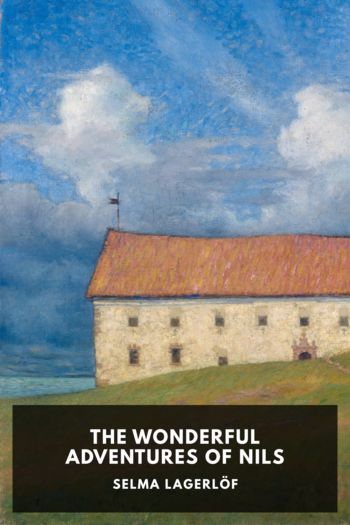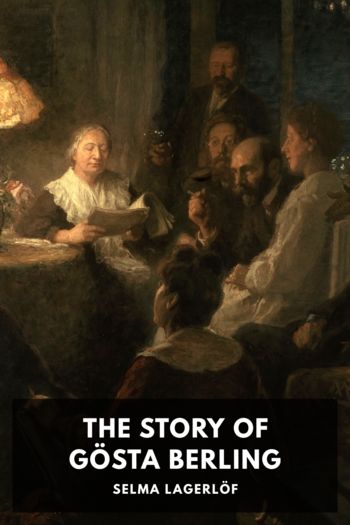The Wonderful Adventures of Nils by Selma Lagerlöf (i can read book club TXT) 📕

Description
In The Wonderful Adventures of Nils, Selma Lagerlöf tells the story of Nils Holgersson, a young boy who is transformed into an elf after a set of misdeeds. Escaping with his family’s farm goose he joins up with a flock of wild geese and travels with them across Sweden as they return to their annual nesting grounds in Lapland.
The story was originally written as a commission for the Swedish National Teachers’ Association to write a geography book for children and has become a firm favourite in the country. It’s been adapted for screen many times, translated into over 30 languages and, until recently, was the artwork on the 20 krona banknote.
Although originally published in English in two volumes—the second starting at “The Story of Karr and Grayskin”—here they are presented as a single combined story.
Read free book «The Wonderful Adventures of Nils by Selma Lagerlöf (i can read book club TXT) 📕» - read online or download for free at americanlibrarybooks.com
- Author: Selma Lagerlöf
Read book online «The Wonderful Adventures of Nils by Selma Lagerlöf (i can read book club TXT) 📕». Author - Selma Lagerlöf
The wild geese understood nothing of what they said, but the boy answered for them: “There, where there are neither machines nor steam-boxes.”
When the workmen heard the answer, they believed it was their own longing that made the goose-cackle sound like human speech. “Take us along with you!”
“Not this year,” answered the boy. “Not this year.”
Next, the geese rode over the well-known match factory, which lies on the shores of Vettern—large as a fortress—and lifts its high chimneys toward the sky. Not a soul moved out in the yards; but in a large hall young working-women sat and filled matchboxes. They had opened a window on account of the beautiful weather, and through it came the wild geese’s call. The one who sat nearest the window, leaned out with a matchbox in her hand, and cried: “Where are you going? Where are you going?”
“To that land where there is no need of either light or matches,” said the boy. The girl thought that what she had heard was only goose-cackle; but since she thought she had distinguished a couple of words, she called out in answer: “Take me along with you!”
“Not this year,” replied the boy. “Not this year.”
East of the factories rises Jönköping, on the most glorious spot that any city can occupy. The narrow Vettern has high, steep sand-shores, both on the eastern and western sides; but straight south, the sand-walls are broken down, just as if to make room for a large gate, through which one reaches the lake. And in the middle of the gate—with mountains to the left, and mountains to the right, with Monk Lake behind it, and Vettern in front of it—lies Jönköping.
The wild geese travelled forward over the long, narrow city, and behaved themselves here just as they had done in the country. But in the city there was no one who answered them. It was not to be expected that city folks should stop out in the streets, and call to the wild geese.
The trip extended further along Vettern’s shores; and after a little they came to Sanna Sanitarium. Some of the patients had gone out on the veranda to enjoy the spring air, and in this way they heard the goose-cackle. “Where are you going?” asked one of them with such a feeble voice that he was scarcely heard.
“To that land where there is neither sorrow nor sickness,” answered the boy.
“Take us along with you!” said the sick ones.
“Not this year,” answered the boy. “Not this year.”
When they had travelled still farther on, they came to Huskvarna. It lay in a valley. The mountains around it were steep and beautifully formed. A river rushed along the heights in long and narrow falls. Big workshops and factories lay below the mountain walls; and scattered over the valley-bottom were the workingmens’ homes, encircled by little gardens; and in the centre of the valley lay the schoolhouse. Just as the wild geese came along, a bell rang, and a crowd of school children marched out in line. They were so numerous that the whole schoolyard was filled with them. “Where are you going? Where are you going?” the children shouted when they heard the wild geese.
“Where there are neither books nor lessons to be found,” answered the boy.
“Take us along!” shrieked the children.
“Not this year, but next,” cried the boy. “Not this year, but next.”
The Big Bird Lake Jarro, the Wild DuckOn the eastern shore of Vettern lies Mount Omberg; east of Omberg lies Dagmosse; east of Dagmosse lies Lake Takern. Around the whole of Takern spreads the big, even Östergöta plain.
Takern is a pretty large lake and in olden times it must have been still larger. But then the people thought it covered entirely too much of the fertile plain, so they attempted to drain the water from it, that they might sow and reap on the lake-bottom. But they did not succeed in laying waste the entire lake—which had evidently been their intention—therefore it still hides a lot of land. Since the draining the lake has become so shallow that hardly at any point is it more than a couple of metres deep. The shores have become marshy and muddy; and out in the lake, little mud-islets stick up above the water’s surface.
Now, there is one who loves to stand with his feet in the water, if he can just keep his body and head in the air, and that is the reed. And it cannot find a better place to grow upon, than the long, shallow Takern shores, and around the little mud-islets. It thrives so well that it grows taller than a man’s height, and so thick that it is almost impossible to push a boat through it. It forms a broad green enclosure around the whole lake, so that it is only accessible in a few places where the people have taken away the reeds.
But if the reeds shut the people out, they give, in return, shelter and protection to many other things. In the reeds there are a lot of little dams and canals with green, still water, where duckweed and pondweed run to seed; and where gnat-eggs and blackfish and worms are hatched out in uncountable masses. And all along the shores of these little dams and canals, there are many well-concealed places, where seabirds hatch their eggs, and bring up their young without being disturbed, either by enemies or food worries.
An incredible number of birds live in the Takern reeds; and more and more gather there every year, as it becomes known what a splendid abode it is. The first who settled there were the wild ducks; and they still live there by thousands. But they no longer own the entire lake, for they have been obliged to share it with swans, grebes, coots, loons, fen-ducks, and a lot of others.
Takern





Comments (0)